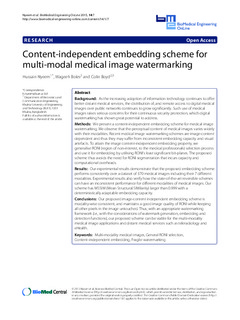| dc.contributor.author | Nyeem, Hussain | |
| dc.contributor.author | Boles, Wageeh | |
| dc.contributor.author | Boyd, Colin Alexander | |
| dc.date.accessioned | 2019-11-13T10:32:13Z | |
| dc.date.available | 2019-11-13T10:32:13Z | |
| dc.date.created | 2015-06-12T13:09:52Z | |
| dc.date.issued | 2015 | |
| dc.identifier.issn | 1475-925X | |
| dc.identifier.uri | http://hdl.handle.net/11250/2628150 | |
| dc.description.abstract | Background
As the increasing adoption of information technology continues to offer better distant medical services, the distribution of, and remote access to digital medical images over public networks continues to grow significantly. Such use of medical images raises serious concerns for their continuous security protection, which digital watermarking has shown great potential to address.
Methods
We present a content-independent embedding scheme for medical image watermarking. We observe that the perceptual content of medical images varies widely with their modalities. Recent medical image watermarking schemes are image-content dependent and thus they may suffer from inconsistent embedding capacity and visual artefacts. To attain the image content-independent embedding property, we generalise RONI (region of non-interest, to the medical professionals) selection process and use it for embedding by utilising RONI’s least significant bit-planes. The proposed scheme thus avoids the need for RONI segmentation that incurs capacity and computational overheads.
Results
Our experimental results demonstrate that the proposed embedding scheme performs consistently over a dataset of 370 medical images including their 7 different modalities. Experimental results also verify how the state-of-the-art reversible schemes can have an inconsistent performance for different modalities of medical images. Our scheme has MSSIM (Mean Structural SIMilarity) larger than 0.999 with a deterministically adaptable embedding capacity.
Conclusions
Our proposed image-content independent embedding scheme is modality-wise consistent, and maintains a good image quality of RONI while keeping all other pixels in the image untouched. Thus, with an appropriate watermarking framework (i.e., with the considerations of watermark generation, embedding and detection functions), our proposed scheme can be viable for the multi-modality medical image applications and distant medical services such as teleradiology and eHealth. | nb_NO |
| dc.language.iso | eng | nb_NO |
| dc.publisher | BMC (part of Springer Nature) | nb_NO |
| dc.rights | Navngivelse 4.0 Internasjonal | * |
| dc.rights.uri | http://creativecommons.org/licenses/by/4.0/deed.no | * |
| dc.title | Content-independent embedding scheme for multi-modal medical image watermarking | nb_NO |
| dc.type | Journal article | nb_NO |
| dc.type | Peer reviewed | nb_NO |
| dc.description.version | publishedVersion | nb_NO |
| dc.source.volume | 14 | nb_NO |
| dc.source.journal | Biomedical engineering online | nb_NO |
| dc.source.issue | 1 | nb_NO |
| dc.identifier.doi | 10.1186/1475-925X-14-7 | |
| dc.identifier.cristin | 1247858 | |
| dc.description.localcode | © 2015 Nyeem et al.; licensee BioMed Central. This is an Open Access article distributed under the terms of the Creative Commons Attribution License (http://creativecommons.org/licenses/by/4.0), which permits unrestricted use, distribution, and reproduction in any medium, provided the original work is properly credited. The Creative Commons Public Domain Dedication waiver (http:// creativecommons.org/publicdomain/zero/1.0/) applies to the data made available in this article, unless otherwise stated. | nb_NO |
| cristin.unitcode | 194,63,30,0 | |
| cristin.unitname | Institutt for informasjonssikkerhet og kommunikasjonsteknologi | |
| cristin.ispublished | true | |
| cristin.fulltext | original | |
| cristin.qualitycode | 1 | |

